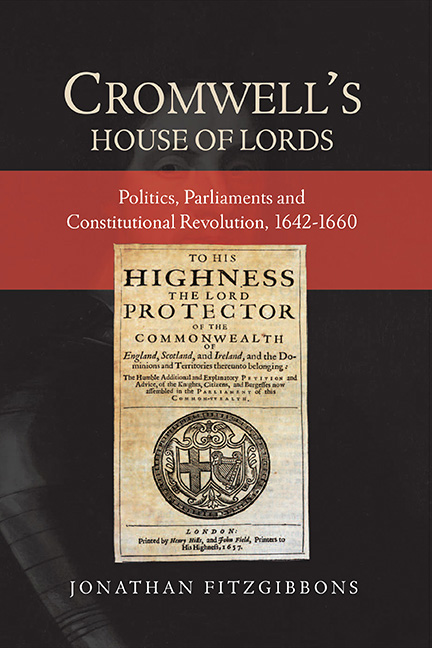Book contents
- Frontmatter
- Contents
- Acknowledgements
- Abbreviations
- Introduction
- 1 Parliamentarian Thought and the Abolition of the House of Lords, 1642–49
- 2 Oliver Cromwell, the Other House and the Humble Petition and Advice
- 3 The Membership of the Other House
- 4 The Other House and the Second Session of the Second Protectorate Parliament
- 5 Richard Cromwell, the Third Protectorate Parliament and the Other House Debates
- 6 The Other House, the Army and the Search for a Settlement
- Conclusion
- Appendix: The Membership of the Other House
- Bibliography
- Index
- Studies in Early Modern Cultural, Political and Social History
- Frontmatter
- Contents
- Acknowledgements
- Abbreviations
- Introduction
- 1 Parliamentarian Thought and the Abolition of the House of Lords, 1642–49
- 2 Oliver Cromwell, the Other House and the Humble Petition and Advice
- 3 The Membership of the Other House
- 4 The Other House and the Second Session of the Second Protectorate Parliament
- 5 Richard Cromwell, the Third Protectorate Parliament and the Other House Debates
- 6 The Other House, the Army and the Search for a Settlement
- Conclusion
- Appendix: The Membership of the Other House
- Bibliography
- Index
- Studies in Early Modern Cultural, Political and Social History
Summary
The House of Lords’ vote in October 2015 to delay controversial cuts to tax credits once again prompted politicians and political commentators to question the place of the upper chamber in Britain's ‘unwritten’ constitution. It was not the first time that a frustrated government majority in the Commons raised the pertinent issue of whether an unelected assembly can legitimately defy the will of the people's representatives – and it is unlikely to be the last.
Indeed, for over a century, the House of Lords has been the subject of sporadic scrutiny over its constitutional role, leading to numerous reforms. The rejection in 1909 of the ‘People's Budget’ by the Lords famously led to the Parliament Act of 1911, which denied them a veto over money bills and allowed them to delay public bills for two years only (reduced to one year by a subsequent Parliament Act of 1949). Besides redefining the relationship between the two Houses, however, the 1911 Parliament Act also hinted at, or threatened, more sweeping changes. The Act's introduction announced that the ultimate aim was to replace the Lords with ‘a Second Chamber constituted on a popular instead of hereditary basis’. Yet, as the Act went on to lament, ‘such substitution cannot be immediately brought into operation’. In the intervening period there have been lurches towards reforming the Lords, including the admission of life peers and women (Life Peerages Act, 1958), and a significant reduction in its hereditary membership (House of Lords Act, 1999). In the past decade, proposals to have a wholly or mostly elected House have fallen by the wayside, yet recent clashes between the Commons and Lords suggest a lingering sense that the Lords must either be reformed further or replaced by a new chamber.
Perhaps those considering the future of the upper chamber should pay more attention to its distant past, particularly the turbulent period in British history from 1640 to 1660. After all, during the course of those two decades the House of Lords was re-formed, abolished, replaced by a new second chamber and ultimately restored.
- Type
- Chapter
- Information
- Cromwell's House of LordsPolitics, Parliaments and Constitutional Revolution, 1642–1660, pp. 1 - 7Publisher: Boydell & BrewerPrint publication year: 2018

